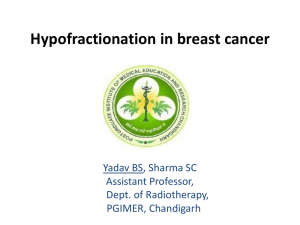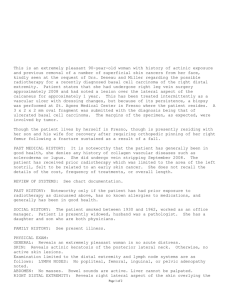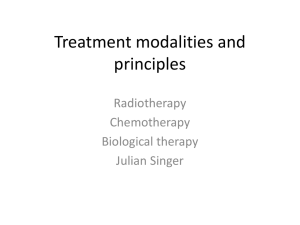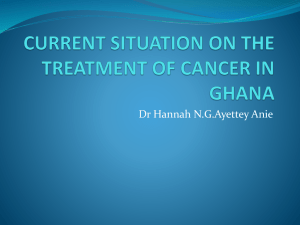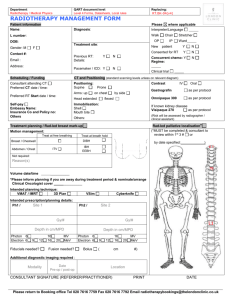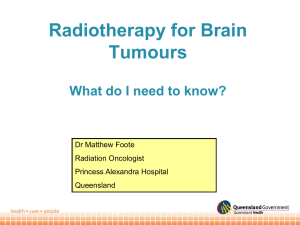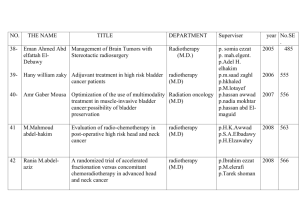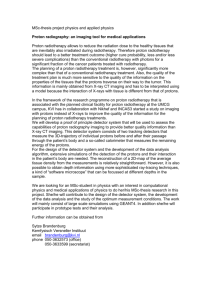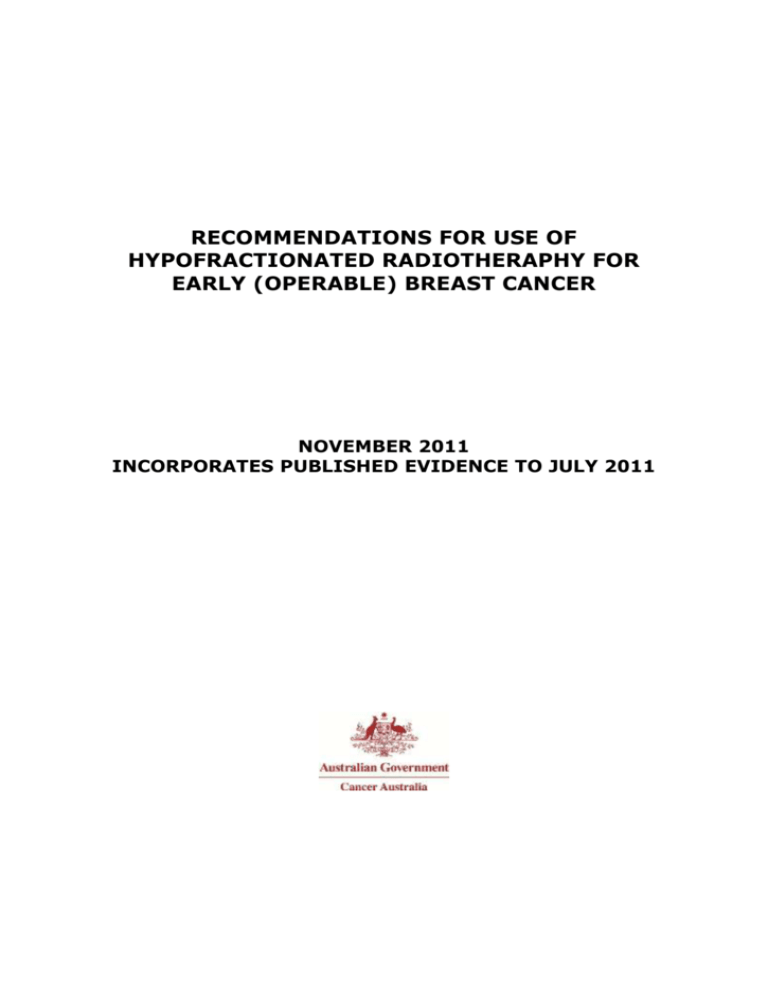
RECOMMENDATIONS FOR USE OF
HYPOFRACTIONATED RADIOTHERAPHY FOR
EARLY (OPERABLE) BREAST CANCER
NOVEMBER 2011
INCORPORATES PUBLISHED EVIDENCE TO JULY 2011
A Clinical Practice Guideline Developed by Cancer
Australia*
This guideline supplements guideline recommendations 10 on the use of radiotherapy
(page 8) and information about radiotherapy (pages 67-75) in the Clinical practice
guidelines for the management breast cancer, 2nd edition 2001.1
ISBN Online: 13 978-1-74127-175-1
©Cancer Australia 2011
Purpose
This guideline includes statements and recommendations based on available, high-level
evidence about the use of hypofractionated radiotherapy for the treatment of women
with early (operable) breast cancer. The guideline aims to provide health professionals
with information designed to assist in making management recommendations for patient
outcomes. These guidelines will inform the development of information specifically for
consumers about early breast cancer, including treatment options.
Endorsed by:
* In July 2011, National Breast and Ovarian Cancer Centre (NBOCC) amalgamated with Cancer Australia to
form a single national agency, Cancer Australia, to provide leadership in cancer control and improve outcomes
for Australians affected by cancer.
Background
Early breast cancer is defined as tumours not more than five centimetres in diameter,
with either impalpable or palpable but not fixed lymph nodes and with no evidence of
distant metastases.1 Primary treatment of early breast cancer usually involves surgery to
remove the tumour (breast conserving surgery or mastectomy) and management of the
axilla.1 Complete pathology reporting following surgery will inform the adjuvant
treatment options for individual women.
Several trials have shown that breast conserving surgery followed by whole breast
radiotherapy is effective in reducing the risk of local recurrence and improving the longterm outcomes of appropriately selected patients with early breast cancer. 2
Conventional adjuvant whole breast radiotherapy is typically delivered over a period of 5
weeks using a standard dose of 2 Gray (Gy) per treatment episode (fraction) in 25
fractions to a total dose of 50 Gy.3 A tumour bed boost of 10-16 Gy in 2 Gy fractions4,5 is
sometimes delivered after whole breast radiotherapy.
Hypofractionated whole breast radiotherapy involves fewer fractions; however each
fraction contains a larger daily dose of radiation than the conventional 2 Gy per fraction.
The total dose of radiation used in a course of hypofractionated radiotherapy is reduced
to compensate for the increased toxicity effect of larger daily fractions.
Compared to conventional radiotherapy regimens, the duration of a hypofractionated
radiation treatment course is shorter by several days or weeks, as fewer fractions are
required. A hypofractionated regimen may be more convenient for patients and lessresource intensive than a conventionally fractionated regimen.6
Conventional radiotherapy and hypofractionated radiotherapy can be hypothesised to
have a similar effect, based on radiobiological principles. The aim of hypofractionated
radiotherapy is to balance as high a daily dose as possible in order to kill tumour cells,
against a dose low enough to minimise the side-effects of treatment.
Sensitivity of tissues to radiation fraction size is described by the / ratio. Low /
values indicate greater sensitivity to fraction size than higher / values. It has been
hypothesised that breast cancer is as sensitive to fraction size as normal breast tissue
with a low / value, and confirmation would indicate that fewer, larger fractions are as
effective as conventional 2 Gy fractions.7
Clinical Practice Recommendations
Please see the statements of evidence on which the recommendations are based.
Recommendations to individual women should be based on their circumstances,
the absolute benefits and harms of treatment, and their personal preferences.
These factors should be discussed with individual women. Women treated with
conventional or hypofractionated radiotherapy should be reviewed regularly
and monitored for side effects and adverse events.
It is important to note that research on hypofractionated whole breast radiotherapy for
early breast cancer is continuing. Clinical judgement should be applied in the context of
the currently available evidence and emerging findings from the continuing body of
research.
In women with early breast cancer who require post-operative whole breast
radiotherapy and for whom hypofractionated radiotherapy is being considered:
Recommendations
Level of Evidence13 Reference
Women should be informed of the potential benefits and risks,
I
and potential side effects and adverse events of hypofractionated
radiotherapy and conventionally fractionated radiotherapy.
NBCC & NCCI
Patient and tumour characteristics
—
—
Hypofractionated radiotherapy can be offered as a suitable
alternative to conventionally fractionated radiotherapy for
women:
I
Cancer Australia
systematic review15
aged 50 years and over
with pathological stage T1-2, N0, M0
with low or intermediate histologic grade breast cancer
who have undergone breast conserving surgery
with clear surgical margins
There is insufficient evidence to make a recommendation for or
against the use of hypofractionated radiotherapy for women:
aged less than 50 years
with pathologic stage T3+ and/or N1 + tumour
with high histologic grade breast cancer
who are treated with total mastectomy
who receive chemotherapy and/or targeted biological
therapies
ASTRO guidelines16
—
Cancer Australia
systematic review15
ASTRO guidelines16
Refer to patient characteristics table for characteristics of trial
populations to inform clinical judgement on the suitability of
hypofractionated radiotherapy for women within or outside the
above criteria.
Optimal schedule
—
—
Recommended hypofractionated schedules for whole breast
radiotherapy, based on current evidence are:
II
Canadian6,
—
START B12
42.5 Gy in 16 fractions given at the rate of one fraction
per day, 5 fractions per week over 22 days
40 Gy in 15 fractions given at the rate of one fraction
per day, 5 fractions per week over 21 days
11
Recommendations
Level of Evidence13 Reference
Adverse events and toxicity
—
When selecting an appropriate radiotherapy schedule,
I
consideration should be given to the possibility of adverse events
including early acute reactions and late toxic effects.
—
Cancer Australia
systematic:
review15
Statements of evidence
Below are the statements of evidence on which the clinical practice recommendations are
based.
In women with early (operable) breast cancer who have undergone total
mastectomy:
Statements
Level of Evidence13 Reference
There is insufficient evidence to inform the safety and efficacy of
hypofractionated chest wall irradiation in women who have
undergone mastectomy.
—
Cancer Australia
systematic review15
In women with early (operable) breast cancer who have undergone breast
conserving surgery:
Statements
Level of Evidence13 Reference
Patient and tumour characteristics
—
—
Hypofractionated radiotherapy is equivalent to conventional
fractionated regimens* of radiotherapy in women aged over 50
years, with pathological stage T1-2, N0, M0 and low to
intermediate histologic grade tumours.
I
Cancer Australia
systematic review15
Due to the relatively small numbers of patients in sub-group
analyses of randomised trials, there is insufficient evidence to
inform the safety and efficacy of hypofractionated radiotherapy
for women:
—
Cancer Australia
systematic review15
Local recurrence
—
—
There are similar rates of local recurrence for women treated
with hypofractionated radiotherapy and conventionally
fractionated radiotherapy at 5-12 years follow-up.
I
Cancer Australia
systematic review15
aged less than 50 years
with locally advanced breast cancer
with a high histologic grade (grade 3) tumour
with node positive disease
who receive chemotherapy and/or targeted biological
therapies. Refer to patient characteristics table.
A hypofractionated radiotherapy regimen of 39 Gy in 13 fractions II
over 35 days is associated with a statistically significant higher
rate of local recurrence compared with a hypofractionated
radiotherapy regimen of 42.9 Gy in 13 fractions over 35 days at
10 years follow-up.
RMH/GOC, 20067
Subgroup analysis of a randomised controlled trial showed that
II
for patients with high grade tumours, the hypofractionated
radiotherapy regimen of 42.5 Gy in 16 fractions over 22 days
was associated with a higher local recurrence rate compared with
conventionally fractionated radiotherapy regimens at 12 years
follow-up.
Canadian6
This finding has not been confirmed in the START A or START B
trials.
III
Haviland17
Loco-regional recurrence
—
—
Statements
Level of Evidence13 Reference
There are similar rates of loco-regional recurrence for women
treated with hypofractionated radiotherapy and conventionally
fractionated radiotherapy regimens at 5 years follow-up.
I
Cancer Australia
systematic review15
Distant recurrence
—
—
One randomised controlled trial reported that a hypofractionated
radiotherapy regimen of 40 Gy in 15 fractions over 21 days is
associated with a statistically significant lower rate of distant
relapse than the conventionally fractionated regimen at 6 years
median follow- up.
II
START B12
Overall survival
—
—
There are similar overall survival rates reported for women
treated with hypofractionated radiotherapy compared with
patients treated with conventionally fractionated radiotherapy at
5-12 years follow-up.
I
Cancer Australia
systematic review15
One randomised controlled trial reported that a hypofractionated II
radiotherapy regimen of 40 Gy in 15 fractions over 21 days was
associated with a statistically significant lower all-cause mortality
at 6 years median follow-up compared with the conventionally
fractionated regimen.
START B12
Adverse events and cosmetic outcomes
—
—
One randomised controlled trial reported that global cosmetic
II
outcome worsened over time for women treated with either
hypofractionated radiotherapy or conventionally fractionated
radiotherapy, however there were no significant differences
observed over 10 years between the hypofractionated regimen of
42.5 Gy in 16 fractions over 22 days and the conventionally
fractionated regimen
Canadian6
One randomised controlled trial reported that the
hypofractionated radiotherapy regimen of 39 Gy in 13 fractions
over 35 days was associated with a lower risk of developing any
late radiation effect than a conventionally fractionated
radiotherapy regimen at 10 years follow-up.
II
RMH/GOC9
However, the hypofractionated regimen of 42.9 Gy in 13
fractions over 35 days was associated with a higher risk of
developing any late radiation effect than a conventionally
fractionated radiotherapy regimen at 10 years follow-up.
II
RMH/GOC9
At 5 years follow-up, measuring changes in skin appearance,
there was a statistically significant difference favouring the
hypofractionated regimens of 39 Gy in 13 fractions over 35 days
(START A) and 40 Gy in 15 fractions over 21 days (START B)
compared to the conventionally fractionated regimen.
II
START A10
Cardiac toxicity
—
START B12
Hopwood18
—
Evidence was insufficient or inconclusive about cardiac toxicity
—
related to hypofractionated radiotherapy in comparison with
conventionally fractionated radiotherapy. However, the heart was
protected from exposure to radiation in randomised controlled
trials.
START A10
Quality of life
—
—
START B12
Statements
Level of Evidence13 Reference
No statistically significant differences in quality of life scores were II
found in women undergoing radiotherapy after surgery between
hypofractionated and conventionally fractionated radiotherapy
regimens at 5 years follow-up.
START A10
Regional nodal radiotherapy
—
—
There is insufficient evidence to support the use of
hypofractionated regional nodal radiotherapy.
—
Cancer Australia
systematic review15
Tumor bed boost
—
—
START B12
There is insufficient evidence to determine the safety and efficacy —
of a tumour bed boost administered in sequence after
hypofractionated whole breast radiotherapy
Cancer Australia
systematic review15
Chemotherapy/Targeted therapies
—
—
There is insufficient evidence to determine the safety and efficacy —
of hypofractionated radiotherapy for women who receive
chemotherapy and/or targeted biological therapies
Cancer Australia
systematic review15
* Conventional regimens of radiotherapy usually involve a dose of 50 Gy in 25 fractions over 5 weeks.
Summary of evidence
The statements and recommendations about the use of hypofractionated radiotherapy for
women with early breast cancer are based on a Cancer Australia systematic literature
review including available evidence from 2001 to March 2010 from randomised controlled
trials. The literature review was undertaken using a systematic method of searching and
selection. Searches for full-length publications and abstracts were conducted in EMBASE,
Medline and the Cochrane Database of Systematic Reviews. A search of conference
websites was also conducted, including the American Society of Clinical Oncology,
American Society of Radiation Oncology and San Antonio Breast Cancer Symposium. A
total of 682 non-duplicate citations were identified. Following application of the exclusion
criteria, a total of 10 citations were identified as eligible for the review. Of the included
citations there were two systematic reviews and five randomised controlled trials (some
trials were reported by multiple citations).
Five randomised controlled trials, including one conference abstract with limited
information available, compared the use of one or more hypofractionated radiotherapy
regimens to a conventional radiotherapy regimen for women with early invasive breast
cancer. The United Kingdom's Royal Marsden Hospital/ Gloucestershire Oncology Centre 7,
9
(RMH/GOC) and the Standardisation of Breast Radiotherapy Trial A10 (START A) tested
two hypofractionated radiotherapy regimens. A Canadian trial 6, 11 and the
Standardisation of Breast Radiotherapy Trial B12 (START B) each tested one
hypofractionated radiotherapy regimen. In all trials, the conventional radiotherapy
regimen used as a comparator was 50 Gy in 25 fractions, delivered over 5 weeks.
A range of hypofractionated radiotherapy regimens were examined, including
39 Gy in 13 fractions over 35 days7,
9-10
40 Gy in 15 fractions over 21 days12
40 Gy in 15 daily fractions8
41.6 Gy in 13 fractions over 35 days10
42.5 Gy in 16 fractions over 22 days6,
42.9 Gy in 13 fractions over 35 days7,9
11
Two trials included women who had undergone breast conserving surgery only.6-7,
Three trials included women who had undergone breast conserving surgery or
mastectomy8, 10, 12
9 11
In patients who had breast conserving surgery, hypofractionated and conventional
radiotherapy regimens were delivered to the whole breast in all five randomised
controlled trials.
Median follow-up ranged from 5.18/ears (4.4 - 6.0 years) in the START A10 trial to 16.9
years (15.4 - 18.8 years) in the trial by Spooner et al.8
Summary of Trial Results
Trial and patient characteristics
Recommendations and statements of evidence have been made on the basis of the
patient populations of the randomised trials. In some instances, patient populations
included in sub-group analysis including age, tumour size and grade, use of tumour bed
boost and use of adjuvant systemic therapies were smaller than required to infer broad
clinical recommendations.
Table 1 identifies trial populations and primary outcomes measured. Of note:
Five trials identified the patient population characteristics as early invasive breast
cancer T1-3, N0-1, M0.6-12
RMH/GOC and the Canadian trial limited the trial populations to those who had
breast conserving surgery only.6-7, 9, 11
Women participating in the Spooner, START A or START B trials had breast
conserving surgery or mastectomy8, 10, 12
Table 1: Trial characteristics
Post breast conserving surgery
Trial
RMH/GOC7,
9
Population
Median
follow-up
(range)
years
Intervention
T1-3, N0-1,
9.7
M0
(7.8-11.8)
39 Gy in 13 fractions over 50 Gy in 25
5 weeks
fractions over 5
weeks
(n=474)
<75 years
42.9 Gy in 13 fractions
over 5 weeks
Comparator
Outcomes
measured
Local recurrence
Cosmetic
outcomes
(n=470)
(n=466)
Canadian6,11
Invasive
12
carcinoma with (range not
negative axillary reported)
nodes
42.5 Gy in 16 fractions
over 22 days
(n=622)
50 Gy in 25
Local recurrence
fractions over 35 Overall survival
days
Adverse events
and toxicity
(n=612)
Cosmetic
outcome
Post breast conserving surgery or mastectomy
Trial
Population
Median
follow-up
(range)
years
START A10
T1-3a, N0-1, M0 5.1
(4.4-6.0)
Intervention
Comparator
39 Gy in 13 fractions over 50 Gy in 25
5 weeks
fractions over 5
weeks
(n=737)
(n=749)
41.6 Gy in 13 fractions
over 5 weeks
(n=750)
START B12
T1-3a, N0-1, M0 6.0
(5.0-6.2)
40 Gy in 15 fractions over 50 Gy in 25
3 weeks
fractions over 5
weeks
(n=1110)
(n=1105)
Spooner8
Stage 1 and 2
Note: Conference abstract Median tumour
only, limited information size 2.0cms
available.
16.9
(15.4-18.8)
Outcomes
measured
Local recurrence
Overall survival
Adverse events
and toxicity
Cosmetic
outcome Quality
of life
Local recurrence
Overall survival
Adverse events
and toxicity
Cosmetic
outcome Quality
of life
40 Gy in 15 daily
fractions
Delayed salvage Time to first
treatment
relapse
or
n=707
50 Gy in 25 daily
fractions
n=707
Table 2 identifies key characteristics of patients involved in four of the randomised
controlled trials
Table 2: Patient characteristics
Patient
RMH/GOC
n=1410
Yarnold9
n
RMH/GOC
n=1410
Yarnold9
%
Canadian
n=1234
Whelan11
n
Canadian
n=1234
Whelan11
%
START A
n=2236
Bentzen10
n
START A
n=2236
Bentzen10
%
START B
n=2215
Bentzen12
n
START B
n=2215
Bentzen12
%
Treated with
breast
conserving
surgery
1410
100%
1234
100%
1900
85%
2038
92%
Age >50 years
987
70%
929
75%
1727
77%
1758
79%
T0-2
1383
98%
994
81%
1741
78%
1987
90%
NO
564
40%
1234
100%
1547
69%
1635
74%
16
Adjuvant treatment
Patient
RMH/GOC
n=1410
Yarnold9
n
RMH/GOC
n=1410
Yarnold9
%
Canadian
n=1234
Whelan11
n
Canadian
n=1234
Whelan11
%
START A
n=2236
Bentzen10
n
START A
n=2236
Bentzen10
%
START B
n=2215
Bentzen12
n
START B
n=2215
Bentzen12
%
None
289
21%
593
48%
172
8%
84
4%
Tamoxifen only 918
65%
505
41%
1210
54%
1592
72%
Patient
RMH/GOC
n=1410
Yarnold9
n
RMH/GOC
n=1410
Yarnold9
%
Canadian
n=1234
Whelan11
n
Canadian
n=1234
Whelan11
%
START A
n=2236
Bentzen10
n
START A
n=2236
Bentzen10
%
START B
n=2215
Bentzen12
n
START B
n=2215
Bentzen12
%
Chemotherapy
only
40
3%
136
11%
245
11%
155
7%
Tamoxifen +
chemotherapy
156
11%
0
0%
548
25%
336
15%
Other
7
1%
0
0%
47
2%
27
1%
High tumour
grade
NR
NR
233
19%
629
28%
509
23%
NR=Not Reported
Local Recurrence
Four trials reported on local recurrence.6-7,10-12 There was no evidence that
hypofractionated radiotherapy regimens were associated with a statistically significant
difference i n local recurrence rate when compared with the control arms of 50 Gy in 25
fractions over 5 weeks.6-7, 10, 12RMH/GOC noted a statistically significant difference in
recurrence rates between the two hypofractionated regimens (42.9 Gy vs 39 Gy: 9.6%
vs 14.83%, p=0.027) but not when either of the hypofractionated regimens was
compared to 50 Gy in 25 fractions.7
Subgroup analyses
Table 3 includes the local tumour recurrence rates reported by the randomised trials.
Subgroup analyses for local recurrence were performed in one trial.6 Analyses showed
that treatment effect was similar regardless of age, tumour size, oestrogen-receptor
status, and use of systemic therapy.
The Canadian, START A and START B trials included 19%, 28% and 23% of patients with
high-grade tumours respectively. Among these women at 12 years follow-up, the
Canadian trial reported a 10-year local recurrence rate of 15.6% for patients treated with
hypofractionated radiotherapy compared to 4.7% for patients who received
conventionally fractionated radiotherapy.6 Results of the START A and START B trials at 8
years follow-up concluded that hypofractionated radiotherapy was equally effective for
high and non-high grade breast cancers.16
In addition, a retrospective cohort study of patients with grade 3 tumours reported no
evidence for inferiority in local control for hypofractionated radiotherapy (42.5-44 Gy in
16 fractions). The 10-year cumulative incidence of local relapse was 6.9% (95% CI 5.48.5%) for the hypofractionated group (n=1083) and 6.2% (95% CI 3.6-9.8%) for the
conventional fractionation group (n=252) (p=0.99).19
Table 3: Five year rates for local recurrence20
Trial
RMH/GOC7,
9
Median follow-up
(range) years
Treatment group
Five year local tumour
recurrence rate (%)
9.7
50 Gy in 25 fractions
over 5 weeks
12.1
(7.8-11.8)
Trial
RMH/GOC7,
9
Median follow-up
(range) years
Treatment group
Five year local tumour
recurrence rate (%)
9.7
42.9 Gy in 13 fractions
over 5 weeks
9.6
39 Gy in 13 fractions
over 5 weeks
14.8
50 Gy in 25 fractions
over 5 weeks
3.2^
42.5 Gy in 16 fractions
over 22 days
2.8^
50 Gy in 25 fractions
over 5 weeks
3.2
41.6 Gy in 13 fractions
over 5 weeks
3.2
39 Gy in 13 fractions
over 5 weeks
4.6
50 Gy in 25 fractions
over 5 weeks
3.3
40 Gy in 15 fractions
over 3 weeks
2.0
(7.8-11.8)
RMH/GOC7,
9
9.7
(7.8-11.8)
Canadian6,
11
12
(not reported)
Canadian6,
11
12
(not reported)
START A10
5.1
(4.4-6.0)
START A10
5.1
(4.4-6.0)
START A
10
5.1
(4.4-6.0)
START B
12
6.0
(5.0-6.2)
START B
12
6.0
(5.0-6.2)
^ 6.7% and 6.2% at 10 years
Loco-regional recurrence
Two trials reported on loco-regional recurrence rates.10, 12 There was no evidence that
any hypofractionated regimen was associated with a statistically significant difference in
local-regional recurrence rate when compared with the control arms of 50 Gy in 25
fractions over 5 weeks.10,12
Distant recurrence
Two trials reported on distant recurrence.10, 12 START B reported that the
hypofractionated regimen of 40 Gy in 15 fractions over 3 weeks had a statistically
significantly lower rate of distant relapse when compared with the conventional regimen
of 50 Gy in 25 fractions over 5 weeks (HR 0.69 95% CI 0.53-0.91 p=0.01).12 START A
found no statistical difference between hypofractionated radiotherapy and the
conventionally fractionated reaimen (41.6 Gy arm, HR 0.92 95% CI 0.66-1.28, p=0.64;
39 Gy arm, HR 1.29 95% CI 0.95-1.76, p=0.10).10
Overall survival
Four trials reported on overall survival.6, 8, 10, 12 START B found that 40 Gy in 15 fractions
over three weeks was associated with a statistically significantly lower all-cause mortality
when compared to 50 Gy in 25 fractions over five weeks (HR 0.76 95% CI 0.59-0.98,
p=0.03).12 The three other trials found no statistically significant difference in overall
survival between hypofractionated and conventional regimens. Therefore, there was no
evidence that hypofractionated radiotherapy was associated with worse overall survival in
comparison to conventionally fractionated radiotherapy.
Adverse events and cosmetic outcomes
Four trials reported on adverse events and cosmetic outcomes.6, 9-10, 12 Across the four
trials and radiotherapy regimens tested, 30-55% of women experienced some change in
breast appearance.
Canadian trial results
The Canadian trial reported on toxic effects of irradiation on the skin and subcutaneous
tissue five and ten years after randomisation.6 The incidence of reported effects
increased over the follow-up period, although the proportion of women with grade 3
radiation-associated skin and subcutaneous tissue morbidity was 4% or less, with no
reports of grade 4 morbidity. At 10 years, there were no skin toxic effects for 70.5% of
women in the conventional radiotherapy group, compared to 69.8% of women in the
hypofractionated radiotherapy group. There were no toxic effects in subcutaneous tissue
in 45.3% of women in the conventional radiotherapy group, compared with 48.1% of
women in the hypofractionated radiotherapy group.6
Following assessments at baseline, three, five and ten years after randomisation, the
global cosmetic outcome worsened over time, however there were no significant
differences observed between the 42.5 Gy group and the 50 Gy group at any time. 6 At
ten years follow-up, 71.3% of women in the 50 Gy group compared to 69.8% of women
in the hypofractionated radiotherapy treatment group had an excellent or good cosmetic
outcome.6 Cosmetic outcome was shown to be affected by time from randomisation,
patient's age and tumour size but there was no interaction with the treatment.6
RMH/GOC trial results
After a minimum follow-up of five years, the proportion of patients who recorded any
change in breast appearance after 50 Gy in 25 fractions, 39 Gy in 13 fractions and 42 Gy
in 13 fractions was 39.6%, 30.3% and 45.7% respectively.9
For photographically assessed changes in breast appearance, the trial found a higher risk
of developing any radiation effect for patients allocated to 42.9 Gy in 13 fractions,
compared to those allocated to 39 Gy in 13 fractions or 50 Gy in 25 fractions (p=<0.001
for comparison of three fractionation schedules).9
Clinical assessment of patients also indicated significant differences between the three
fractionation schedules, with the 42.9 Gy group experiencing the highest incidence of
events for overall breast cosmesis (p=<0.001), breast shrinkage (p=0.026), breast
distortion (p=0.005), breast oedema (p=0.004), induration (p=0.001) and shoulder
stiffness (p=0.001).9
START A and START B trial results
START A found that according to patient self-assessments of five normal tissue effects on
the breast or breast area* the rates of moderate or marked effects at five years were
similar for 41.6 Gy and 50 Gy.10 Rates of moderate or marked normal tissue effects
tended to be lower after treatment in the 39 Gy group compared to the 50 Gy group,
with a significantly lower rate of change in skin appearance (p=0.004). Changes in breast
appearance and breast hardness were the most common changes reported. 10
START A also measured change in breast appearance using photographic assessment;
the hazard ratios for any change in breast appearance compared to the 50 Gy arm was
1.09 (p=0.62) after 41.6 Gy and 0.69 (p=0.01) after 39 Gy.10
Although mostly not statistically significant, the patient quality of life self-assessments of
normal tissue effects in START B suggested that cosmetic outcomes were favourable in
the 40 Gy group in most of the assessed normal tissue effects, with a significantly lower
rate of change in skin appearance compared to the 50 Gy treatment arm (p=0.02).12
Changes in breast appearance and breast hardness were the most common changes
reported. Photographic assessments also showed that change in breast appearance was
less likely after treatment in the 40 Gy arm than the 50 Gy arm with a hazard ratio of
0.83 (p=0.06).12
Combined results of the START A and START B trials found that any change in skin
appearance occurred significantly less often in the 39 Gy and 40 Gy arms when
compared with the control arms of 50 Gy in 25 fractions over five weeks (39 Gy HR 0.63
95% CI 0.47-0.84, p=0.0019 and 40 Gy HR 0.76 95% CI 0.60-0.97, p=0.0262).18
Other adverse events
Three trials investigated the incidence of symptomatic lung fibrosis and symptomatic rib
fracture.10-12 The reported rates were low at 5 years follow-up, and balanced between the
regimens. One woman in the 41.6 Gy arm of the START A trial developed pneumonitis
nine months after treatment; another developed mild signs of brachial plexopathy two
years following treatment.10 The Canadian trial reported four cases of pneumonitis (two
women in the 42.5 Gy group, and two women in the 50 Gy treatment group).11 One
woman in the 50 Gy treatment group experienced rib fracture attributed to radiation
therapy.11
While damage to the pectoral muscle has been highlighted as a possible concern, 20 none
of the trials reported this outcome.
Cardiac toxicity
No trials reported the long-term effects of radiotherapy on cardiac tissues; however the
START A authors noted the need to protect the heart from exposure to radiotherapy as a
priority.10 The Canadian trial identified no significant difference in overall survival
between the conventional and hypofractionated radiotherapy regimens; at a median
follow-up of 12 years, few cardiac-related deaths were observed, and no increase
occurred in patients who received the hypofractionated schedule.6
The START A and START B trials report that the incidence of ischaemic heart disease was
low at five years follow-up; however, the authors noted that 15-20 years of, follow-up
would be required to reliably measure the late normal tissue effects including cardiac
damage.10, 12
Quality of life
Two trials reported quality of life outcomes using the European Organisation for Research
and Treatment of Cancer (EORTC) breast cancer module.10, 12 Three subscales were used
in the analysis: breast symptoms (pain, swelling, oversensitivity, and skin problems in
the breast); arm or shoulder symptoms subscale (swelling in the arm or hand, arm or
shoulder pain, and difficulty moving the arm); and body image subscale. Based on these
measures, there was no evidence that a hypofractionated radiotherapy regimen was
associated with a statistically significant difference in quality of life scores. 18 Subgroup
analysis by surgery type was performed. The small numbers of patients and events in
some subgroups limited the statistical power of these analyses. There were no
statistically significant differences in outcomes based on trial groups; nor were any
interaction tests significant overall. 10, 12
No other assessment of patient quality of life was available. Authors of the Canadian trial
suggested that the inconvenience of a prolonged course of daily treatment made a
substantial contribution to the decreased quality of life experienced by women treated
with radiotherapy for breast cancer.11 A shorter fractionation schedule lessens the
practical burden of treatment for women, and will have important quality of life benefits
with respect to convenience and less time away from home and work.
Regional nodal radiotherapy
Three trials included women undergoing regional nodal radiotherapy. 9-10, 12 RMH/GOC
trial reported that 20.6% of patients underwent regional nodal radiotherapy to the axilla
and/or supraclavicular fossa.9 There were no recorded cases of brachial plexopathy
among these women.
START A reported that the decision to administer regional nodal radiotherapy was made
pre-randomisation and was used in approximately 14% of patients.10 One patient
developed mild symptoms of brachial plexopathy but it was not reported if the patient
received regional nodal radiotherapy. In two patients randomised to the 41.6 Gy arm and
prescribed radiotherapy to the breast and supraclavicular fossa, the total dose was
reduced to 39 Gy because of concerns regarding sensitivity of brachial plexus to fraction
size.10
START B reported that 7.3% of patients received regional nodal radiotherapy. 12 No cases
of brachial plexopathy were reported among the women given radiotherapy to the
supraclavicular fossa, axilla or both.12
Use of tumour bed boost
Tumour bed boost was used in three of the randomised trials.9-10, 12 Between January
1986 and July 1997, patients in the RMH/GOC trial were randomly assigned to receive a
boost or not. Subsequently, all patients were offered an elective boost. The proportion of
women who received a tumour bed boost was similar among the treatment groups.10
There was a statistically significant reduced risk of induration (p=0.001) and
telangiectasia (p=0.026) in patients randomised to no boost. 9
The proportion of women who received a tumour bed boost was similar among the
treatment groups in the START A and START B trials. However, sub-group analysis on
tumour bed boost was not reported.10, 12
Use of adjuvant systemic therapies
Four trials included women who received adjuvant systemic therapies.6-7, 10, 12 In the
Canadian trial, 11% of women received chemotherapy in both the conventional and
hypofractionated radiotherapy regimens; and 41% received tamoxifen in both the
conventional and hypofractionated radiotherapy regimens.6 Sub-group analysis of the
rates of local recurrence showed no statistically significant difference between the
conventional and hypofractionated regimens at five years and ten years.6
No sub-group analys is on the use of systemic therapies was reported in the RMH/GOC,
START A or START B trials.7, 9- 0| 12 In each trial, the proportions of women who received
systemic therapies including tamoxifen and/or chemotherapy were similar among the
study grou ps. The START trials required a two week gap between exposure to
chemotherapy and radiotherapy.10, 12
No trials specifically assessed the use of hypofractionated radiotherapy in conjunction
with chemotherapy or other biological therapies.
Delivery of radiotherapy
Four trials provided information on the radiotherapy techniques used. Patients in all four
trials were treated in a supine position. The RMH/GOC and Canadian trials specified that
patients were treated with one or both arms raised above the shoulder.
In all four trials, 6-megavoltage x-rays were used for most patients but higher energy
megavoltage x-rays or cobalt x-rays were also used. Where regional radiotherapy was
indicated, the target volume included the supraclavicular nodes with or without the
axillary nodes. 7, 10, 12
Four trials reported that the maximum dose to the breast on the central axis was no less
than 93% to 95% and no more than 105% to 107% of the prescribed dose. 6-7, 9-12 The
Canadian trial excluded patients whose separation along the central axis exceeded 25cm;
however the other trials used higher energy x-rays for patients with larger breasts to
achieve acceptable dose homogeneity.6-7, 10-12 RMH/GOC and Canadian trials reported the
use of wedge tissue compensators to ensure a uniform dose distribution throughout the
target volume.7, 9 11
Three trials included women allocated to receive a tumour bed boost.9-10, 12Women
allocated to receive a boost in RMH/GOC received a dose of 14 Gy to the 90% isodose
(15.5 Gy to 100%) in 7 daily fractions.9 Ten Gy in 5 daily fractions to the 100% isodose
was delivered after whole breast radiotherapy to women allocated to receive a boost in
the START A and START B trials.10, 12
*Patient quality of life self-assessments include the following changes since radiotherapy - breast shrinkage;
breast hardness; change in skin appearance; swelling in area of affected breast; change in breast appearance.
Strengths and weaknesses of evidence
Overall the evidence included in the systematic review was of high quality. 15 One trial,
Spooner8, was rated as low quality evidence, as results were limited to one conference
abstract. All trials included populations of over 700 women.15
All reported outcomes need to be considered in the context of the range of
hypofractionated radiotherapy regimens that were evaluated. Although 50 Gy in 25
fractions was used as a control arm in all trials, six different hypofractionated
radiotherapy regimens were investigated.
Not all trials were powered to detect a difference in all outcomes. RMH/GOC and the
Canadian trial were powered to detect a difference in local tumour recurrence rates.
START A and START B were powered to detect a difference in local-regional tumour
relapse rate. The included trials had a follow-up period of 5-17 years.15
Unanswered questions
Important unanswered questions about the use of hypofractionated radiotherapy in early
breast cancer are outlined below. Some of these questions may be addressed in ongoing
trials:
Treatment outcomes for patients who received hypofractionated radiotherapy in
relation to age, tumour size and histologic grade
Optimal hypofractionated radiotherapy schedule
Safety and efficacy of tumour bed boost administered after hypofractionated
radiotherapy
Safety and efficacy of hypofractionated regional nodal radiotherapy
Hypofractionated radiotherapy for DCIS
Potential interactions between adjuvant systemic therapies and hypofractionated
radiotherapy
Long-term effects of hypofractionation on cardiac toxicity
Long-term effects of hypofractionation on rib morbidity
Psychosocial outcomes for women receiving hypofractionated radiotherapy,
including impact of hypofractionated radiotherapy on quality of life, such as sideeffects and practical implications of a shorter treatment schedule
Health economic considerations of hypofractionated radiotherapy
Ongoing Trials
One randomised controlled trial investigating the use of hypofractionated radiotherapy
for early breast cancer is ongoing:
FAST Trial** (UK) compares 28.5 Gy or 30 Gy in five once-weekly fractions of 5.7
Gy or 6.0 Gy respectively, with a control dose of 50Gy in 25 fractions over 5
weeks, delivered with three dimensional dose-compensated whole-breast
radiotherapy.
**First results of the FAST Trial have indicated the 28.5 Gy in 5 fractions schedule was comparable to the
schedule 50 Gy in 25 fractions, and milder than the 30 Gy in 5 fractions schedule, for adverse effects on breast
appearance.21
International Guidelines
The American Society for Radiation Oncology (ASTRO) guidelines on fractionation
for whole breast irradiation 201016
The New Zealand Ministry of Health Guidelines for Management of Early Breast
Cancer 2009
NICE 2009 Guidelines for early and locally advanced breast cancer
Conclusion
Overall, there was no evidence that any of the hypofractionated radiotherapy regimens
investigated in the randomised controlled trials was associated with a statistically
significant difference in local recurrence rate or a significantly worse overall survival rate
when compared to a conventionally fractionated regimen. However, subgroup analysis of
one randomised controlled trial 6 showed adverse local control outcomes for patients with
a high grade tumour treated with hypofractionated radiotherapy after breast conserving
surgery. This has not been confirmed in other trials. There were some differences in
adverse events, toxicity and cosmetic outcomes, although they were not consistent
across the hypofractionated radiotherapy protocols.
These results should be considered in the context of the included patient populations,
statistical power of the trials, variations in the hypofractionated radiotherapy regimens
used and lengths of follow-up. There were insufficient patient numbers in the trials to
make a definitive recommendation about the integration of systemic therapy, regional
nodal radiotherapy and tumour bed boost in patients who receive hypofractionated
radiotherapy. Adverse events including cosmetic outcomes are important considerations
for women receiving radiotherapy. Clinicians should consider and discuss with women the
absolute benefits and harms when considering a hypofractionated radiotherapy regimen.
References
1. National Breast Cancer Centre. Clinical practice guidelines for the management of
early breast cancer (2nd edition). Commonwealth of Australia: Canberra, 2001.
2. Early Breast Cancer Trialists' Collaborative Group (EBCTCG). Effects of radiotherapy
and of differences in the extent of surgery for early breast cancer on local recurrence and
15-year survival: an overview of the randomised trials. Lancet 2005;366(9503):20872106.
3. James ML, Lehman M, Hider PN, et al. Fraction size in radiation treatment for breast
conservation in early breast cancer. Cochrane Database Syst Rev 2008;3):CD003860.
4. Faculty of Radiation Oncology and The Royal Australian and New Zealand College of
Radiologists. RANZCR The Clinicians guide to radiation oncology. M Barton, Editor:
Sydney, 2002.
5. Poortmans PM, Collette L, Bartelink H, et al. The addition of a boost dose on the
primary tumour bed after lumpectomy in breast conserving treatment for breast cancer.
A summary of the results of EORTC 22881-10882 "boost versus no boost" trial. Cancer
Radiother 2008;12(6-7):565-70.
6. Whelan TJ, Pignol JP, Levine MN, et al. Long-term results of hypofractionated radiation
therapy for breast cancer. N Engl J Med 2010;362(6):513-20.
7. Owen JR, Ashton A, Bliss JM, et al. Effect of radiotherapy fraction size on tumour
control in patients with early-stage breast cancer after local tumour excision: long-term
results of a randomised trial. Lancet Oncol 2006;7(6):467-71.
8. Spooner D, Stocken DD, Jordan S, et al. A randomised controlled trial to evaluate both
the role and optimal fractionation of radiotherapy in the conservative management of
early breast cancer. San Antonio Breast Cancer Symposium, 2008.
9. Yarnold J, Ashton A, Bliss J, et al. Fractionation sensitivity and dose response of late
adverse effects in the breast after radiotherapy for early breast cancer: long-term results
of a randomised trial. Radiother Oncol 2005;75(1):9-17.
10. Bentzen SM, Agrawal RK, Aird EG, et al. The UK Standardisation of Breast
Radiotherapy (START) Trial A of radiotherapy hypofractionation for treatment of early
breast cancer: a randomised trial. Lancet Oncol 2008;9(4):331-41.
11. Whelan T, MacKenzie R, Julian J, et al. Randomized trial of breast irradiation
schedules after lumpectomy for women with lymph node-negative breast cancer. J Natl
Cancer Inst 2002;94(15):1143-50.
12. Bentzen SM, Agrawal RK, Aird EG, et al. The UK Standardisation of Breast
Radiotherapy (START) Trial B of radiotherapy hypofractionation for treatment of early
breast cancer: a randomised trial. Lancet 2008;371(9618):1098-107.
13. National Health and Medical Research Council. How to use the evidence: assessment
and application of scientific evidence. Canberra: Commonwealth of Australia, 2000.
14. National Breast Cancer Centre and National Cancer Control Initiative. Clinical practice
guidelines for the psychosocial care of adults with cancer. Commonwealth of Australia:
Canberra, 2003.
15. Cancer Australia. A systematic literature review of hypofractionated radiotherapy for
the treatment of early breast cancer. NBOCC: Surry Hills NSW, 2010.
16. Smith BD, Bentzen SM, Correa CR, et al. Fractionation for Whole Breast Irradiation:
An American Society for Radiation Oncology (ASTRO) Evidence-Based Guideline. Int J
Radiat Oncol Biol Phys 2011;81(1):59-68.^
17. Haviland JS, Yarnold JR and Bentzen SM. Hypofractionated radiotherapy for breast
cancer. N Engl J Med 2010;362(19):1843; author reply 1843-4.
18. Hopwood P, Haviland JS, Sumo G, et al. Comparison of patient-reported breast, arm,
and shoulder symptoms and body image after radiotherapy for early breast cancer: 5year follow-up in the randomised Standardisation of Breast Radiotherapy (START) trials.
Lancet Oncol 2010;11(3):231-40.
19. Herbert C, Nichol A, Olivotto I, et al. The Impact of Hypofractionated Whole Breast
Radiotherapy on Local Relapse in Patients with Grade 3 Early Breast Cancer: A
Population-based Cohort Study. Int J Radiat Oncol Biol Phys 2011;April 6th(epub ahead
of print):1-7.^
20. Yarnold J, Bentzen SM, Coles C and Haviland J. Hypofractionated whole-breast
radiotherapy for women with early breast cancer: myths and realities. Int J Radiat Oncol
Biol Phys 2011;79(1):1-9.
21. The FAST Trialists group. First results of the randomised UK FAST Trial of
radiotherapy hypofractionation for treatment of early breast cancer (CRUKE/04/015).
Radiother Oncol 2011;100(1):93-100.^
These articles were considered by the NBOCC's Hypofractionated radiotherapy working group but published
after March 2010.
^
Acknowledgements
Membership of Hypofractionated Radiotherapy Working
Group
This guideline was developed by a multidisciplinary working group convened by NBOCC*.
Name
Group
A/Prof Boon Chua (Chair)
Radiation oncologist
Dr Marie-Frances Burke
Radiation oncologist
Prof Geoff Delaney
Radiation oncologist
Dr Jane O'Brien
Breast surgeon
Ms Jan Rice
Breast care nurse
Ms Geraldine Robertson
Consumer representative
Dr Kirsty Stuart
Radiation oncologist
NBOCC acknowledges the Breast Cancer Steering Committee, chaired by Dr Catherine
Shannon, for their input into the development of this guideline.
NBOCC Staff
Name
Position
Ms Katrina Anderson
Project Officer - Research
Ms Phillipa Hastings
Project Officer
Dr Anne Nelson
Evidence Review & Research Leader
Ms Sue Sinclair
General Manager
Ms Heidi Wilcoxon
Program Manager
External Review
NBOCC acknowledges those who gave their time to provide comment on the draft
guideline recommendations as part of the external review process.
Topic-specific guideline development process
Priority topic areas for guideline development are determined in consultation with key
stakeholders including experts in relevant disciplines and consumer representatives. A
specific multidisciplinary Working Group, including consumers, is established for each
topic identified and is involved in all aspects of guideline development. A systematic
evidence review is undertaken for each guideline. All members are asked to declare any
conflicts of interest and these declarations are recorded. The content of the guideline is
not influenced by any external funding body. The guideline is reviewed externally by key
stakeholders and the wider community and endorsement is sought from relevant
professional colleges and groups in Australia.
Acknowledgement
The National Breast Cancer Foundation provided funding for the development and
production of this guideline.
* In July 2011, National Breast and Ovarian Cancer Centre (NBOCC) amalgamated with Cancer Australia to
form a single national agency, Cancer Australia, to provide leadership in cancer control and improve outcomes
for Australians affected by cancer.
Additional Information
Cancer Australia*
Locked Bag 3 Strawberry Hills NSW 2012 Australia
Tel: +61 2 9357 9400 Fax: +61 2 9357 9477
Website: http://canceraustralia.nbocc.org.au/
© Cancer Australia 2011
This work is copyright. You may reproduce the whole or part of this work in unaltered
form for your own personal use or, if you are part of an organisation, for internal use
within your organisation, but only if you or your organisation do not use the reproduction
for any commercial purpose and retain this copyright notice and all disclaimer notices as
part of that reproduction. Apart from rights to use as permitted by the Copyright Act
1968 or allowed by this copyright notice, all other rights are reserved and you are not
allowed to reproduce the whole or any part of this work in any way (electronic or
otherwise) without first being given the specific written permission from Cancer Australia
to do so. Requests and inquiries concerning reproduction and rights are to be sent to the
Publications and Copyright contact officer, Cancer Australia, Locked Bag 3, Strawberry
Hills NSW 2012.
Recommended citation
Cancer Australia. Recommendations for use of Hypfractionated radiotherapy for early
(operable) breast cancer. Cancer Australia, Surry Hills, NSW, 2011.
Disclaimer
Cancer Australia does not accept any liability for any injury, loss or damage incurred by
use of or reliance on the information. Cancer Australia develops material based on the
best available evidence, however it cannot guarantee and assumes no legal liability or
responsibility for the currency or completeness of the information.
* In July 2011, National Breast and Ovarian Cancer Centre (NBOCC) amalgamated with Cancer Australia to
form a single national agency, Cancer Australia, to provide leadership in cancer control and improve outcomes
for Australians affected by cancer.

